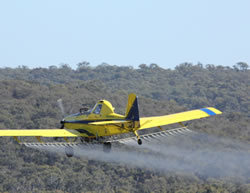 Parks Victoria has joined forces with the Department of Environment, Energy and Climate Action (DEECA) and Corangamite Catchment Management Authority to combat a deadly plant pathogen in and around the Great Otway National Park.
Parks Victoria has joined forces with the Department of Environment, Energy and Climate Action (DEECA) and Corangamite Catchment Management Authority to combat a deadly plant pathogen in and around the Great Otway National Park.
Regional Conservation Program Coordinator at Parks Victoria, Katrina Lovett said ‘dieback’ (Phytophthora cinnamomi) was a deadly disease which devastated native plants like grass trees and the native animals that relied them, like the Southern Brown Bandicoot and Long-nosed Potoroo.
“To slow the spread, a trial is underway to reduce the impact of dieback through Victoria’s first aerial application of phosphite, a low toxicity salt-like chemical over the Anglesea and Carlisle Heathland.,” Ms Lovett said.
“We can protect large amounts of bushland fairly quickly and easily using aerial spraying,” she said.
“The chemical, already used in Western Australia, works by boosting plant defences against Phytophthora, giving native species a fighting chance to survive.”
Project Officer for Wild Otways at DEECA, Tim Miller said the trial would provide insight into the effectiveness of aerial spraying across a large area, and would help to inform the future use of phosphite to protect and support native vegetation in the Otways and across Victoria.
Mr Miller said the aerial application was part of the broader Wild Otways Initiative to map the occurrence of the disease in the Otways, prioritise areas for protection, and train staff, community groups and Traditional Owner groups to further prevent the spread of the disease.



